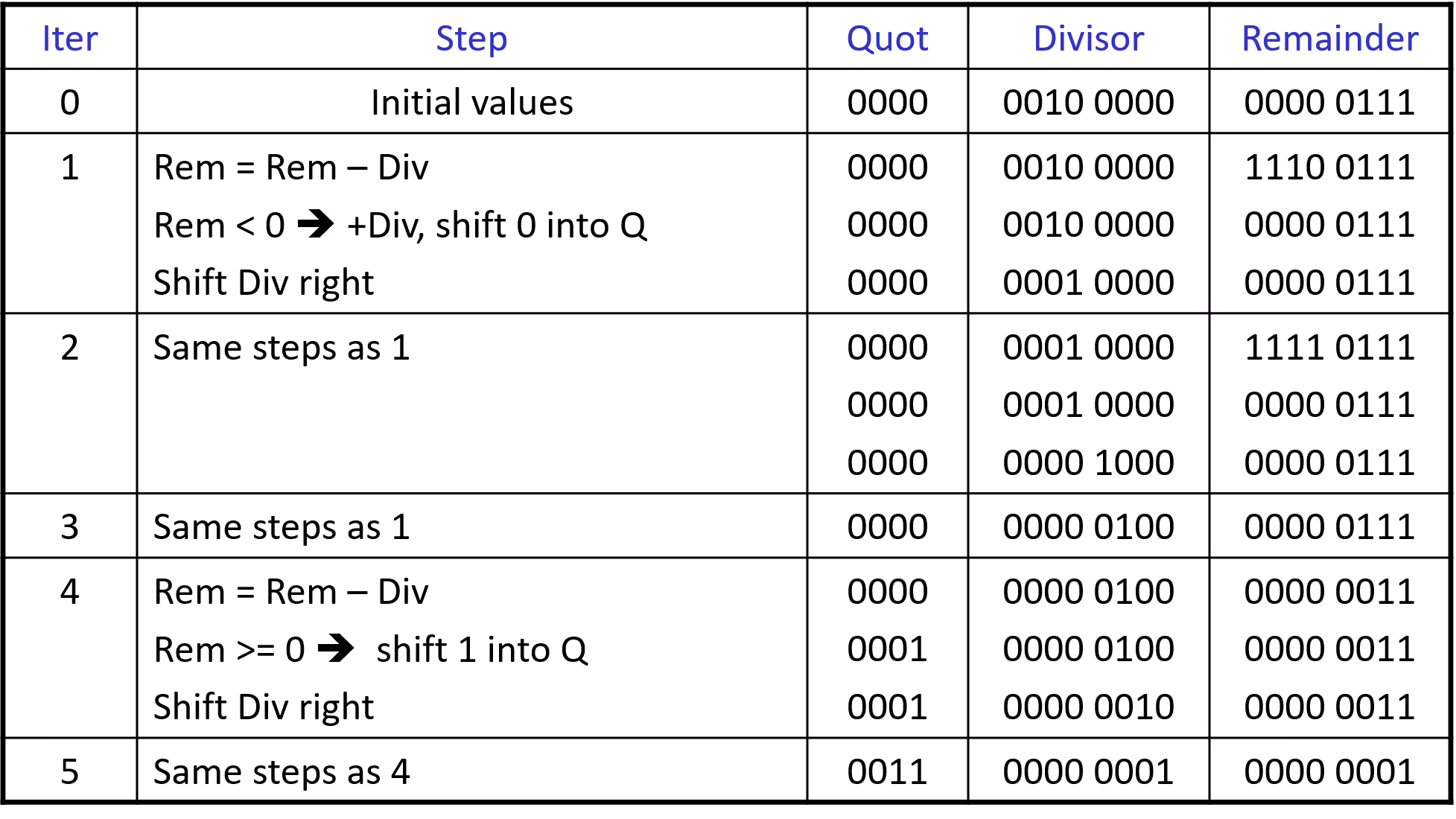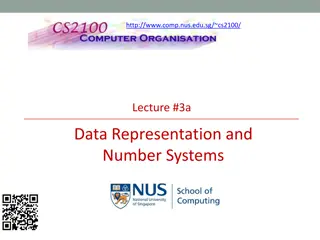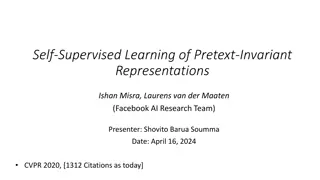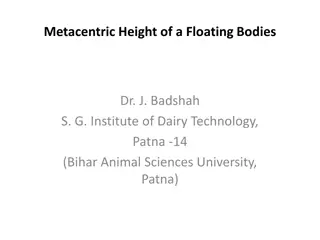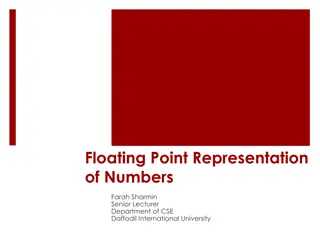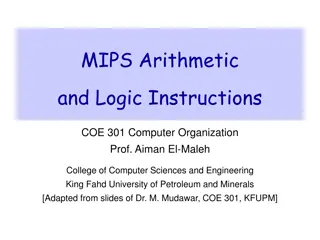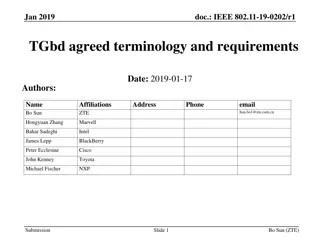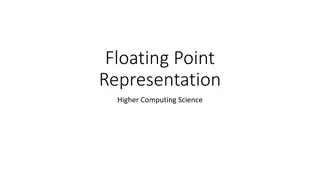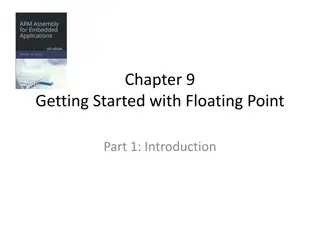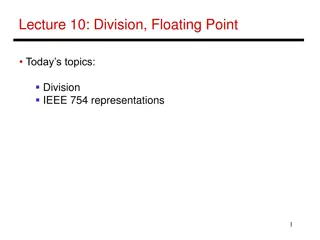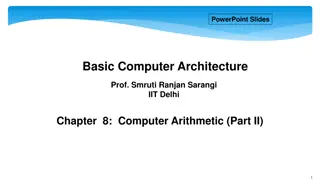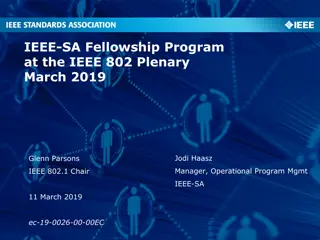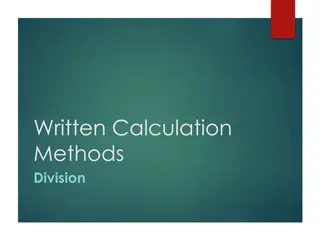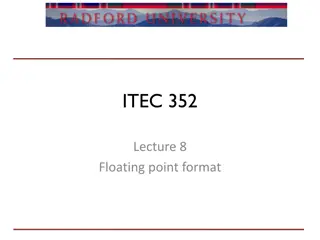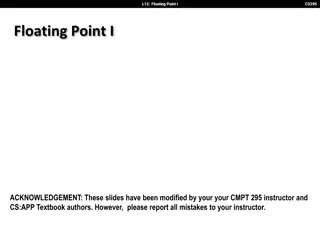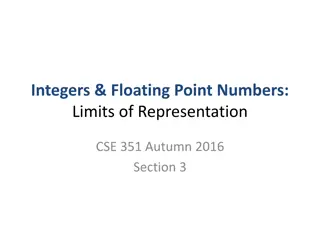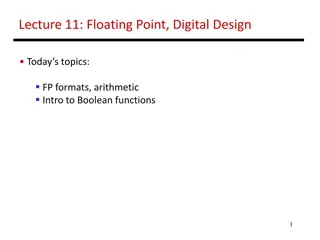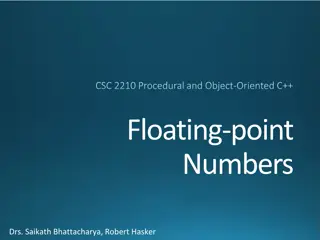Division in IEEE 754 Floating Point Representations
Today's lecture delves into division in IEEE 754 representations, illustrating the step-by-step process with examples. The division hardware process, efficient division methods, and handling divisions involving negatives are also covered, emphasizing strategies for simplification and efficiency in algorithms. Key takeaways include utilizing grade school algorithms, implementing binary operations in hardware, and optimizing efficiency by identifying ineffectual operations.
Download Presentation

Please find below an Image/Link to download the presentation.
The content on the website is provided AS IS for your information and personal use only. It may not be sold, licensed, or shared on other websites without obtaining consent from the author.If you encounter any issues during the download, it is possible that the publisher has removed the file from their server.
You are allowed to download the files provided on this website for personal or commercial use, subject to the condition that they are used lawfully. All files are the property of their respective owners.
The content on the website is provided AS IS for your information and personal use only. It may not be sold, licensed, or shared on other websites without obtaining consent from the author.
E N D
Presentation Transcript
Lecture 10: Division, Floating Point Today s topics: Division IEEE 754 representations 1
Divide Example Divide 7ten (0000 0111two) by 2ten (0010two) Iter Step Quot Divisor Remainder 0 Initial values 0000 0010 0000 0000 0111 1 Rem = Rem Div Rem < 0 +Div, shift 0 into Q Shift Div right 0000 0000 0000 0010 0000 0010 0000 0001 0000 1110 0111 0000 0111 0000 0111 2 Same steps as 1 0000 0000 0000 0001 0000 0001 0000 0000 1000 1111 0111 0000 0111 0000 0111 3 Same steps as 1 0000 0000 0100 0000 0111 4 Rem = Rem Div Rem >= 0 shift 1 into Q Shift Div right 0000 0001 0001 0000 0100 0000 0100 0000 0010 0000 0011 0000 0011 0000 0011 5 Same steps as 4 0011 0000 0001 0000 0001 2
Hardware for Division Source: H&P textbook A comparison requires a subtract; the sign of the result is examined; if the result is negative, the divisor must be added back Similar to multiply, results are placed in Hi (remainder) and Lo (quotient) 3
Efficient Division 4 Source: H&P textbook
Divisions involving Negatives Simplest solution: convert to positive and adjust sign later Note that multiple solutions exist for the equation: Dividend = Quotient x Divisor + Remainder +7 div +2 Quo = Rem = -7 div +2 Quo = Rem = +7 div -2 Quo = Rem = -7 div -2 Quo = Rem = 5
Divisions involving Negatives Simplest solution: convert to positive and adjust sign later Note that multiple solutions exist for the equation: Dividend = Quotient x Divisor + Remainder +7 div +2 Quo = +3 Rem = +1 -7 div +2 Quo = -3 Rem = -1 +7 div -2 Quo = -3 Rem = +1 -7 div -2 Quo = +3 Rem = -1 Convention: Dividend and remainder have the same sign Quotient is negative if signs disagree These rules fulfil the equation above 6
Take Homes Grade school algorithms are commonly used the algorithms are even easier in binary (mult by 1 and 0) They can be implemented in hardware with shifts, add, sub, checks To improve efficiency, look for ineffectuals are only some bits changing in every step allows us to use narrow adders and registers allows us to pack more operands in one register Can also improve speed by throwing more transistors and parallel computations at the problem 7
Floating Point Normalized scientific notation: single non-zero digit to the left of the decimal (binary) point example: 3.5 x 109 1.010001 x 2-5two = (1 + 0 x 2-1 + 1 x 2-2+ + 1 x 2-6) x 2-5ten A standard notation enables easy exchange of data between machines and simplifies hardware algorithms the IEEE 754 standard defines how floating point numbers are represented 8
Sign and Magnitude Representation Sign Exponent Fraction 1 bit 8 bits 23 bits S E F More exponent bits wider range of numbers (not necessarily more numbers recall there are infinite real numbers) More fraction bits higher precision Register value = (-1)S x F x 2E Since we are only representing normalized numbers, we are guaranteed that the number is of the form 1.xxxx.. Hence, in IEEE 754 standard, the 1 is implicit Register value = (-1)S x (1 + F) x 2E 9
Exponent Representation To simplify sort, sign was placed as the first bit For a similar reason, the representation of the exponent is also modified: in order to use integer compares, it would be preferable to have the smallest exponent as 00 0 and the largest exponent as 11 1 This is the biased notation, where a bias is subtracted from the exponent field to yield the true exponent IEEE 754 single-precision uses a bias of 127 (since the exponent must have values between -127 and 128) double precision uses a bias of 1023 Final representation: (-1)S x (1 + Fraction) x 2(Exponent Bias) 10
Sign and Magnitude Representation Sign Exponent Fraction 1 bit 8 bits 23 bits S E F Largest number that can be represented: 2.0 x 2128 = 2.0 x 1038 (not really see upcoming details) Smallest number that can be represented: 1.0 x 2-127 = 2.0 x 10-38 (not really see upcoming details) Overflow: when representing a number larger than the max; Underflow: when representing a number smaller than the min Double precision format: occupies two 32-bit registers: Largest: Smallest: Sign Exponent Fraction 1 bit 11 bits 52 bits S E F 11
Details The number 0 has a special code so that the implicit 1 does not get added: the code is all 0s (it may seem that this takes up the representation for 1.0, but given how the exponent is represented, that s not the case) (see discussion of denorms in the textbook) The largest exponent value (with zero fraction) represents +/- infinity The largest exponent value (with non-zero fraction) represents NaN (not a number) for the result of 0/0 or (infinity minus infinity) Note that these choices impact the smallest and largest numbers that can be represented 12
Value inf Value NAN Highest value ~2 x 2127 2 special cases up top that use the reserved exponent field of 255 0 255 00 0 0 255 xx .x 0 254 11 .1 Value 1 0 127 00 0 Exponent field < 127, i.e., after subtracting bias, they are negative exponents, representing numbers < 1 Smallest Norm 1 x 2-126 Largest Denorm ~1 x 2-126 Smallest Denorm ~2-149 0 0..01 00 0 0 0..00 11 1 0 0..00 00 1 Special case with exponent field 0, used to represent denorms, that help us gradually approach 0. Denorms don t have implicit 1. They have exp 2-126 Value 0 0 00..0 00 0 Same rules as above, but the sign bit is 1 Same magnitudes as above, but negative numbers 13
Examples Final representation: (-1)S x (1 + Fraction) x 2(Exponent Bias) Represent -0.75ten in single and double-precision formats Single: (1 + 8 + 23) Remember: +127 True exponent Exponent in register -127 Double: (1 + 11 + 52) What decimal number is represented by the following single-precision number? 1 1000 0001 01000 0000 14
Examples Final representation: (-1)S x (1 + Fraction) x 2(Exponent Bias) Represent -0.75ten in single and double-precision formats Single: (1 + 8 + 23) 1 0111 1110 1000 000 Double: (1 + 11 + 52) 1 0111 1111 110 1000 000 What decimal number is represented by the following single-precision number? 1 1000 0001 01000 0000 -5.0 15
Example 2 Final representation: (-1)S x (1 + Fraction) x 2(Exponent Bias) Represent 36.90625ten in single-precision format 36 / 2 = 18 rem 0 18 / 2 = 9 rem 0 9 / 2 = 4 rem 1 4 / 2 = 2 rem 0 2 / 2 = 1 rem 0 1 / 2 = 0 rem 1 0.90625 x 2 = 1.81250 0.8125 x 2 = 1.6250 0.625 x 2 = 1.250 0.25 x 2 = 0.50 0.5 x 2 = 1.00 0.0 x 2 = 0.0 0.90625 is 0.1110100 0 36 is 100100 16
Example 2 Final representation: (-1)S x (1 + Fraction) x 2(Exponent Bias) We ve calculated that 36.90625ten= 100100.1110100 0 in binary Normalized form = 1.001001110100 0 x 25 (had to shift 5 places to get only one bit left of the point) The sign bit is 0 (positive number) The fraction field is 001001110100 0 (the 23 bits after the point) The exponent field is 5 + 127 (have to add the bias) = 132, which in binary is 10000100 The IEEE 754 format is 0 10000100 001001110100 ..0 sign exponent 23 fraction bits 17





